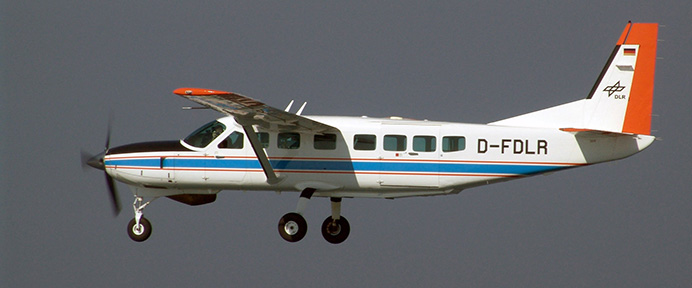Aircraft: C 208 - DLR
Dimensions
- Length: 12.6 m
- Height: 4.6 m
- Wingspan: 16.0 m
 12.6 m
4.6 m
16.0 m
12.6 m
4.6 m
16.0 m
Flying performances
Speed| Min speed | 50 m/s |
| Max speed | 85 m/s |
| Usual speed during measurements | 0 m/s |
| Usual speed during transit flights | 75 m/s |
| Ascent rate | 3 m/s |
| Min altitude |
|
| Max ceiling | 20 000 ft |
| Usual ceiling during measurements | 15 000 ft |
| Ceiling limitations | n/c |
| Empty weight | 2 545 kg |
| Max take-off weight | 3 977 kg |
| Max payload | 1 200 kg |
| Max scientific payload | n/c |
| Usual scientific payload during measurements | 483 kg |
| Scientific payload for max endurance | n/c |
Endurance
| Max endurance at min scientific payload and max fuel | 5 h (Y-coordinate of 1st point) |
| Endurance at max scientific payload | n/c |
Range
| Max range | 1 026 km (at min scientific payload and max fuel) |
| Conditions for max range |
At FL180, 2224 lbs fuel, 45 min reserve |
| Range at max scientific payload | None km |
| Usual range during measurement flight | 0 km |
Other
| Weather conditions limitations |
VFR, IFR. Max. alt. in icing conditions : 20000 ft (when equipped with appropriate options) |
| Take-off runway length | 740 m |
| Engines | 1 x Pratt&Whitney PT6A 114A |
| Avionics | 2 NAV / COM / Glideslope Transceivers, 1 HSI, 1 NAV Indicator, 1 RMI, 1 Intercom System with cabin speakers, 5 cabin stations and Marker Beacon, 1 DME with indicator, 2 Transponder with encoding Altimeter,1 Autopilot, 1 Yaw Damper, 1 Altitude preselect with vertical speed, 1 colour weather radar, 1 IFR approach capable GPS approved for IFR flight under TSO C-129, Class A1, which allows IFR navigation for en route, terminal, and non-precision approach. Choice of Atlantic, Pacific or America���?�s database. |
Crew and scientists on board
| Crew (pilots + operators) |
VFR 2 pilots ; IFR 2 pilots + 1 Mechanic |
| Seats available for scientists | 1 - 8 |
Cabin
| Length | 6.40 m |
| Width | 1.57 m |
| Height | 1.30 m |
| Apertures | cargo door: W1.23 m x H1.23 m |
| Cabin pressurized | no |
| More information | no |
Aircraft modifications
| Nose boom | no |
| Windows | no |
| Openings | 2 openings at the the bottom of fuselage are provided to install cameras, scanners and other instruments (H0.68 m x W0.63 m) ; 2 openings (D0.15 m each) at the bottom fuselage ; 2 openings at the cabin-top opposite the large camera-ports for installation of antennae or other light sensors. |
| Hard points | 1 hard point below each wing (max 120 kg) |
| Inlets | n/c |
| Additionnal systems | no |
Acquisition systems
Storage medium : 2 card bus hard discs (512 MB)
ARINC 429 and RS232/RS485
Electrical power
| Aircraft total electrical power (kW) | DC 28 V max 200 A (VFR) 100 A (IFR) |
| Electrical power (kW) and voltages (V) available for scientists | 28 V max 200 A (VFR) / 100 A (IFR)Conversion to 220 V/50 Hz ; 115 V/400 Hz available on request. 4 sockets fused with 50 amps and 4 sockets fused with 20 amps (28VDC). |
